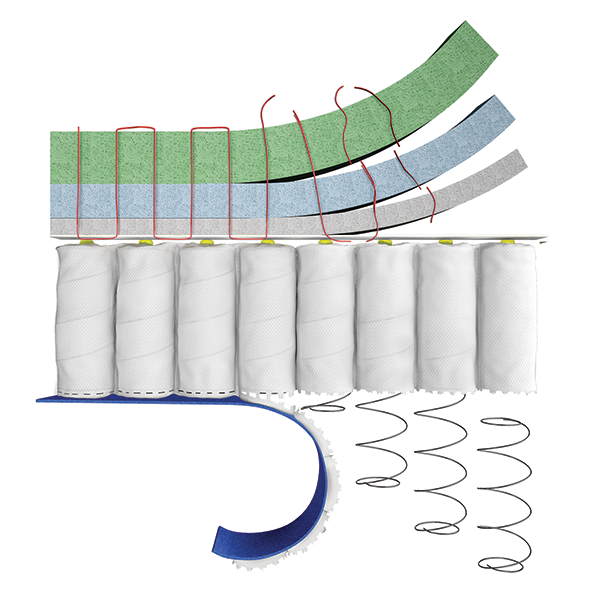Leggett & Platt Inc., which produces components and machinery for the mattress industry and other sectors, wanted to address the issue of pocketed spring recycling by reimagining how a pocketed spring mattress could be constructed in the first place.
L&P has developed a system it calls Rest in Pieces. Jason Jewett, vice president of product development for the Carthage, Missouri-based company, recently demonstrated the concept to BedTimes via video chat.

“Our solution is a little different from others in that we didn’t want to focus just on one mattress component,” he says. “We wanted to address the whole mattress.”
The idea behind Rest in Pieces started with an L&P team looking at a common hybrid mattress construction that includes a pocketed spring unit made of polypropylene fabric and steel coils. That’s often topped with multiple layers of foam that are glued to each other and then glued to a scrim layer on the top of the spring unit. A layer of base foam is also typically glued to the bottom of the spring unit.
The construction can be tough to dismantle cleanly and quickly at a recycling facility. With Rest in Pieces, L&P made several adjustments to make disassembly more manageable.
First, the company uses its Gribetz XT9 glueless lamination system to stitch together the top foam layers. That makes it easier to pull them apart at end of life — especially useful if the layers include a mix of latex, viscoelastic and polyurethane foams headed for different recycling streams, Jewett says.
But, he says, “while the XT9 substantially decreases the amount of necessary adhesive within the comfort layer, we wanted to also address the adherence of that layer to the pocketed coil unit in order to increase the recycling efficiency at end of life.”
L&P’s solution is to affix a thin polypropylene scrim layer between the foams and the spring unit with a strong polypropylene adhesive, which is also used within the spring unit itself. “Then, at end of life,” Jewett says, “you’re able to easily separate the top foam layers, and the polypropylene fabric layer remains with the pocket coil unit.”
The fabric encasement and scrim can then be separated from the steel coils which, due to the inherently circular nature of steel, can be recycled into new steel coils. L&P has added a feature — a perforation in the fabric coil encasement — that makes that separation even easier. “That perforation works almost like a FedEx envelope, where you’re able to grab the string and peel it open,” Jewett explains.
Rest in Pieces incorporates one more L&P innovation. Earlier this year, the company unveiled its Eco-Base spring system, which doesn’t require the typical inch of polyurethane foam on the underside of the pocketed coil unit. Eco-Base reduces the need for glue and, in another nod to sustainability, also reduces the amount of petrochemical-based foam in the mattress.
Together, these innovations make Rest in Pieces “a nice, elegant solution that’s easy to understand, environmentally friendly and financially friendly,” Jewett says.
L&P plans to feature Rest in Pieces during ISPA EXPO, March 12-14, in Columbus, Ohio. “We think of this as a concept car,” Jewett says. “It’s an idea that’s evolved over the past few years, and we want to put it out there to provoke industry conversation around sustainable mattress design from a holistic perspective.”




